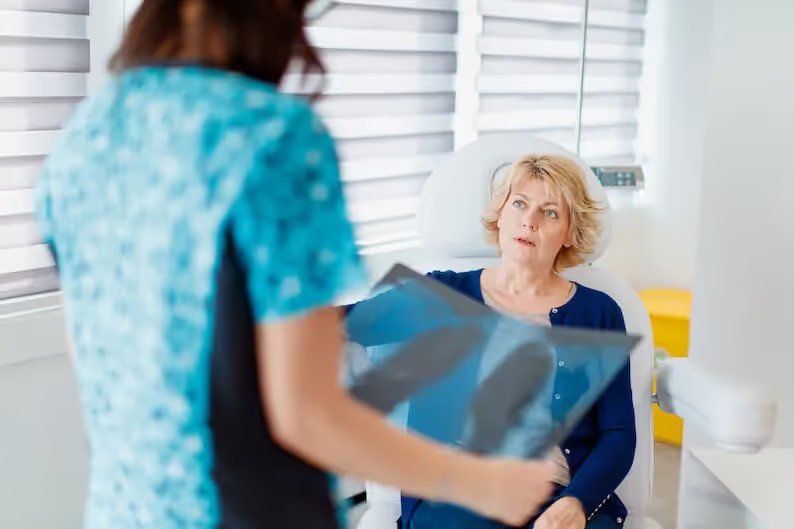Lung cancer is the leading cause of cancer in the United States. Every three minutes, someone is diagnosed with lung cancer. It makes up almost 25 percent of all cancer deaths. It's a vicious disease that is primarily diagnosed in individuals 65 or older, with the average age of people when diagnosed being about 70.
For many, lung cancer can seem like a death sentence. Survival rates are not usually as high as with other cancers and diseases. But it's important to remember that every patient and every diagnosis is different. Research continues to find new comprehensive therapies and treatments that can extend life expectancy and improve quality of life in those diagnosed. If you're older, here's what you need to know about lung cancer in seniors, from symptoms to diagnosis to treatment.
What is Lung Cancer?
It used to be believed that most people who were diagnosed with lung cancer were smokers. That's no longer the case. Fifteen percent of people diagnosed with lung cancer never smoked, and 60 percent of those diagnosed are former smokers.
Lung cancer is a disease in which cells in and around the lungs begin to grow out of control. It begins in the lungs and can spread to the lymph nodes or other parts of the body. There are two main types of lung cancer: small cell and non-small cell.
Small cell lung cancer is a rare, aggressive form of lung cancer that is fast-growing and usually caused by smoking. It begins when healthy cells in your lungs mutate into cancerous cells and start to divide and multiply uncontrollably. The cells eventually clump together to form tumors in your lungs. These tumors then shed cancer cells that are carried throughout your body by blood or lymph, a fluid that travels to your lymph nodes.
Non-small cell lung cancer is the most common type of lung cancer and occurs when abnormal cells form and multiply in your lung tissue. Unlike small cell lung cancer, non-small cell is typically extremely slow-growing and is often diagnosed once the cancer has metastasized or spread to other areas of the body.
Each cancer gets its name from what it looks like under the microscope.
Lung Cancer Symptoms in Seniors
Unfortunately, most lung cancers in seniors fail to have symptoms until they have already spread to other areas of the body. This is why it's important to get checked out for even the slightest sign, regardless if you think it is caused by something else.
The most common symptoms of lung cancer include:
- A cough that does not go away or gets worse
- Coughing up blood or rust-colored sputum (spit or phlegm)
- Chest pain that is often worse with deep breathing, coughing, or laughing
- Hoarseness
- Loss of appetite
- Unexplained weight loss
- Shortness of breath
- Feeling tired or weak
- Infections such as bronchitis and pneumonia that don't go away or keep coming back
- New onset of wheezing
As you can see, this list of symptoms can easily be mistaken for something other than lung cancer. It's better to be safe than sorry. Once lung cancer has spread, it may bring about other symptoms, including:
- Bone pain, such as in the back or hips
- Nervous system changes, such as headache, weakness or numbness of an arm or leg, dizziness, balance problems, or seizures
- Yellowing of the skin and eyes (jaundice)
- Swelling of lymph nodes (collection of immune system cells), such as those in the neck or above the collarbone
Lung Cancer Diagnosis
Because lung cancer doesn't always display symptoms at the onset, it's important to stay up to date with all annuals, check-ups, and routine exams. Early detection is key to treating lung cancer in seniors. If you're at risk for developing lung cancer, whether it be because of family history or you used to or currently smoke, you may want to consider annual lung cancer screening.
There are a few different ways to detect lung cancer, including:
Imaging tests – X-rays or CT scans can be used to take images of your lungs to look for abnormal masses or nodules. CT scans will actually show small lesions on your lungs that are not detected using an X-ray.
Sputum cytology – If you have a persistent cough with sputum discharge, your doctor may order a test to examine your sputum under a microscope, which can detect lung cancer cells.
Tissue sample (biopsy) – If abnormal cells or masses are detected, a tissue sample may be taken to perform a biopsy.
Once you have been diagnosed with lung cancer, your doctor will order other tests to determine the stage or extent of your cancer.
Treatment Options for Lung Cancer
What kind of treatment is available depends on a number of factors, such as your overall health and what stage of cancer you have.
You and your doctor will work together to determine the best treatment option for your specific case. Some individuals choose not to undergo therapy feeling the side effects of treatment will outweigh the benefits. As we mentioned earlier, every person and every case is different.
Treatment options often include:
Surgery – If the cancer is contained in the lungs, surgery may be a viable option. During surgery, your doctor will work to remove the cancerous tissue from your lungs. Sometimes, that includes removing a section of or an entire lung and lymph nodes.
Radiation – This type of therapy uses high-powered energy beams to target and kill the cancer cells.
Chemotherapy – Often used in conjunction with surgery and radiation, chemotherapy uses drugs to kill cancer cells, either intravenously or orally.
Immunotherapy – Generally reserved for advanced lung cancer patients, immunotherapy uses your immune system to fight the cancer.
Work to Prevent Lung Cancer with Better Health
Prevention is key to keeping yourself healthy and lung cancer free. There are many risk factors that are out of your control, and that's why you need to take control of the ones you can. If you smoke, stop! And no matter what,maintain a healthy lifestyle with a nutritious diet and physical exercise. We are only given one body and must do our part to keep it healthy.




